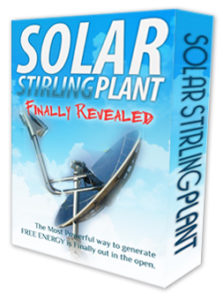Solar Stirling Plant Review

Solar power for home energy production is becoming big, as costs of the technology drop and prices for commercially-
However, solar panels are not the only option for producing energy from sunlight. The other category of solar electricity production is solar thermal power, in which mirrors are used to concentrate sunlight on a point target and a process at that target generates electricity. The Solar Stirling Plant is an application of this principle. A guide to building one is available from solarstirlingplant.com for a bit less than $50. It’s also possible to find solar Stirling generators for purchase online.
The web site (solarstirlingplant.com) uses language that is unfortunately similar to certain free-
Review
The only caution would be that the information of how to build a solar Stirling plant is surely available elsewhere. It’s also possible that the unsupported claims on the web site are not accurate, for example the claim that the solar Stirling plant in the design produces power 12 times more efficiently than solar panels. The company offers a 60-
How It Works
The Solar Stirling Plant uses a parabolic mirror that can be moved to face the best direction for gathering sunlight, focused on a Stirling engine that powers a generator. A Stirling engine is a variant on the same principle as the steam engine (it was invented by Robert Stirling as a safer alternative to the steam engine), in which a contained gas is heated and cooled, expanding and contracting as a result, and generating motion that drives a motor.
The heat source for the Stirling engine in a solar Stirling plant is of course sunlight focused by the parabolic mirror.
Criticism
One thing I wasn’t able to discover about the solar Stirling plant described in the e-
The cost per generator seems on the whole fairly low, probably less than $200 for materials and components; the question remains then of how many of them would be required to power a typical house. One advantage of the solar Stirling plant is that, like all generators, it will produce alternating current, negating any need for a converter as is required with solar panels.
Conclusion
At least two clear disadvantages are apparent. One is that the solar Stirling plant has moving parts, which means that over time it will necessitate more maintenance. Another is that it requires elevation, which means that if installed on a rooftop it will be more exposed than solar panels and could be damaged more easily by birds, animals, thrown objects, etc. However, there’s no doubt that the system works, and is worth taking a serious look at as an alternative for generating power.